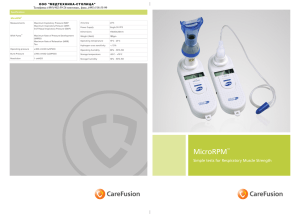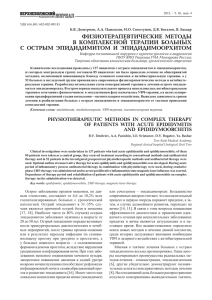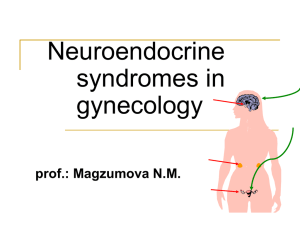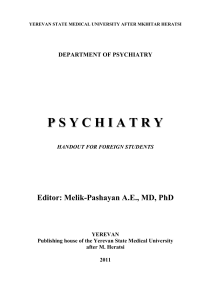Диагностика, классификация и лечение пневмонии на анлийском языке
реклама
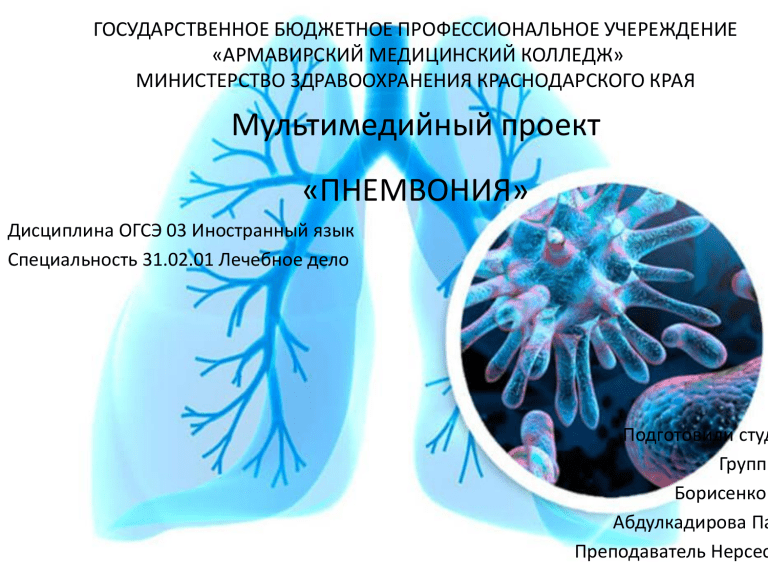
ГОСУДАРСТВЕННОЕ БЮДЖЕТНОЕ ПРОФЕССИОНАЛЬНОЕ УЧЕРЕЖДЕНИЕ «АРМАВИРСКИЙ МЕДИЦИНСКИЙ КОЛЛЕДЖ» МИНИСТЕРСТВО ЗДРАВООХРАНЕНИЯ КРАСНОДАРСКОГО КРАЯ Мультимедийный проект «ПНЕМВОНИЯ» Дисциплина ОГСЭ 03 Иностранный язык Специальность 31.02.01 Лечебное дело Подготовили студ Группы Борисенко Абдулкадирова Па Преподаватель Нерсес Content 1. 2. 3. 4. 5. 6. 7. 8. 9. 10. What is pneumonia? Etiology Pathogenesisof Classification Clinical manifestations Syndromes Complications Diagnostics Treatment Sources What is pneumonia? Pneumonia is an acute infectious disease, mainly of bacterial etiology, characterized by a focal lesion of the respiratory parts of the lungs, the presence of alveolar exudation inside, detected by physical and or instrumental examination, expressed to varying degrees by a febrile reaction and intoxication Etiology The pathogens with a high "tropicity" to the lung tissue include pneumococcus (Streptococcus pneumoniae). Atypical microorganisms: 1. Chlamydophila pneumoniae; 2. Mycoplasma of pneumonia; 3. Legionella pneumophila. Pathogenesisof 4 main mechanisms of development: 1. Aspiration of oropharyngeal secretions; 2. Inhalation of aerosol containing microorganisms; 3. Hematogenic spread of the pathogen from the extrapulmonary focus of infection (tricuspid valve endocarditis, septic thrombophlebitis of pelvic veins); 4. Pathogenesis direct spread of infection from neighboring tissues (for example, liver abscess) or infection with penetrating chest wounds. Classification Epidemiology: 1. Nosocomial pneumonia; 2. Community-acquired pneumonia; 3. Aspiration pneumonia; 4. Pneumonia in people with immunodeficiency; By etiology: 1. Bacterial; 2. Viral – influenza, adenovirus; 3. Fungal – candidiasis, aspergillosis, pneumocystosis. According to pathogenesis and nosology: 1. Primary - in practically healthy individuals (the main disease); 2. Secondary - in respiratory diseases, in severe patients (more often – a complication). Clinical, morphological and nosological: 1. Parenchymal; 2. Bronchopneumonia; 3. Interstitial. 1. 2. 3. 4. 5. 1. 2. 1. 2. 3. 1. 2. By prevalence: One-sided, two-sided; Acinar; Segmental and polysegmental; Lobar; Subtotal and total. Downstream Spicy; Prolonged (more than 3-4 weeks). By severity Easy; Moderate severity; Heavy. By the presence of complications Complicated; Uncomplicated; Clinical manifestations Suspicion of pneumonia should occur if the patient has fever in combination with complaints of cough, shortness of breath, sputum separation and or chest pain. Complaints of unmotivated weakness, fatigue, heavy sweating at night. During physical examination: dullness of percussion sound over the site of lung inflammation, locally listened bronchial breathing, focus of sonorous small-bubbly wheezing or crepitation, increased bronchophony and vocal trembling. Syndromes 1. 2. 3. 4. 5. 6. 7. 1. 2. 1. 2. Syndrome of inflammatory changes in the lungs: dry or productive cough; chest pain with coughing and deep breathing; shortness of breath;increase in body temperature; feeling of heat, chills; increased vocal tremor and bronchophony over the lesionthe focus of blunting or shortening of the pulmonary sound; weakening of vesicular or the appearance of hard or bronchial breathing; wet, sonorous wheezing or crepitation over the focus of inflammation. Intoxication syndrome: weakness,headache,lethargy, apathy, drowsiness, confused consciousness, delirium, hallucinations, sopor; muscle pain and arthralgia,decreased appetite. Respiratory failure syndrome: shortness of breath,reduction of pO2 and accumulation of CO2; development of acidosis,the need for a ventilator. Complications 1. 2. 3. 4. 5. 1. 2. 3. 4. 5. 6. Pulmonary complications of pneumonia: Respiratory failure of I – III degree; Acute respiratory distress syndrome(noncardiogenic pulmonary edema); Exudative pleurisy(parapneumonic pleuraleffusion); Empyema of the pleuraLung abscess; Bronchospastic syndrome. Extrapulmonary complications of pneumonia: Infectious and toxic shock(acute vascular, cardiac, renalinsufficiency, DIC syndrome); Sepsis; Infectious and allergic myocarditis; Intoxication psychoses; Toxic hepatitis; Infectious and toxic kidney. Risk factors for pneumonia 1. 2. 3. 4. 5. 6. 7. 8. 9. Hypothermia; Old age; Smoking and alcohol abuse; Fatigue and stress; Adverse environmental and occupational factors; Chronic bronchitis, acute respiratory infections congestion in the lungs; Immunodeficiency conditions; Stay in air-conditioned rooms; Prolonged bed rest. Diagnostics X-ray examination, CT; The main radiological sign of pneumonia is local shading, infiltration of lung tissue, accompanied by clinical symptoms of acute inflammatory process in the lungs. Laboratory diagnostics: • A general blood test; • Biochemical blood analysis; • Microbiological diagnostics. The material for the study is sputum; • Determination of antigens (PCR, ELISA). Invasive diagnostic methods. Treatment Etiotropic therapy consists in prescribing antibiotics to patients after receiving the results of microbiological examination of the biomaterial. Pneumococci are sensitive to drugs from the group: 1. Penicillins — Ampicillin, Oxacillin; 2. Cephalosporins — "Cefotaxime", "Cefazolin"; 3. Fluoroquinolones — "Ofloxacin", "Ciprofloxacin"; 4. Carbopenem — "Imipenem", "Meropenem". Pathogenetic treatment includes: 1. Detoxification — intravenous administration of colloidal and crystalloid solutions; 2. Improvement of microcirculation — "Cavinton", "Trental"; 3. Dilution and removal of sputum — "ACC", "Ambrobene"; 4. Normalization of the heart — "Trimetazidine", "Mildronate"; 5. Correction of the protective functions of the body — "Immunal", "Imunorix", "Ismigen"; 6. Restoration of normal microflora in the body — "Bifiform", "Linex", "Acipol". Symptomatic treatment consists in the application of: 1. Antipyretics — "Nurofen" and "Panadol" for children, "Fervex" and "Paracetamol" for adults; 2. Analgesics — Ketorol, Baralgin, Analgin; 3. Anti—inflammatory drugs - Ibuprofen, Nimesil, Diclofenac; 4. Antihistamines — Suprastin, Tavegil, Zirtek. Distracting and local therapy — alkaline inhalations, decoctions of medicinal herbs, irrigation of the throat with antiseptics, instillation of the nose and eyes with anti-inflammatory drops. Physiotherapy — UHF therapy, physical therapy, inhalations. Sources 1. https://studfile.net/preview/6824982/page:3/ 2. 3. 4. 5. https://nsportal.ru/npo-spo/zdravookhranenie/library/2015/05/04/pnevmoniya https://ppt-online.org/405739 http://www.myshared.ru/slide/1376387/ https://prezentacii.org/prezentacii/prezentacii-po-medicine/113350pnevmonija.html


